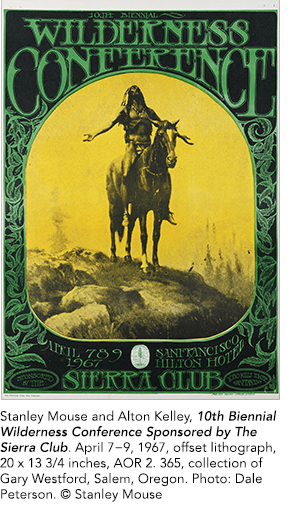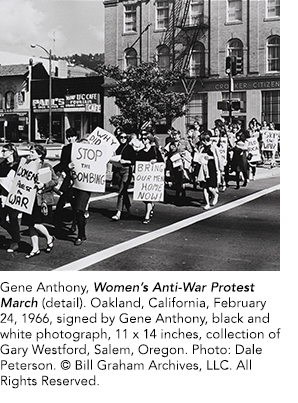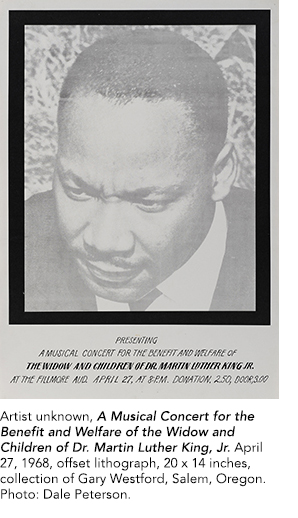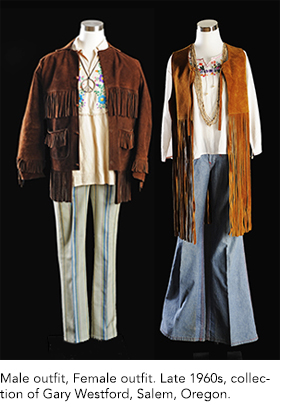
Salem, Oregon, artist Gary Westford brings his passion for the 60s and its psychedelic posters and fashion to the Hallie Ford Museum of Art through two exhibitions: Turned On!: American Blacklight Posters, 1967-71, and Behind the Beyond: Psychedelic Posters and Fashion in San Francisco, 1966-71.
While attending San Francisco State College during the 60s Westford became fascinated by psychedelic posters and fashion. As he witnessed numerous historic protests and the counterculture movement firsthand, he began to collect posters and fashion. As we celebrate the 50th anniversary of the Summer of Love, it is our pleasure to feature his remarkable collection.
Gary is an emeritus instructor in art and art history at Linn-Benton Community College. He has also worked as an instructor of painting at Portland Community College, in a prison education program at the Oregon State Penitentiary administered through Chemeketa Community College, as a visiting professor in painting at Linfield College, and as an instructor of visual fundamentals at University of California at Santa Cruz.
Westford's paintings and drawings have been included in 11 solo exhibitions and 25 group exhibitions in the Western United States.

The Power of a Poster
It was the spring of 1967, and Gary Westford had his first encounter with the psychedelic movement when he stepped into his speech instructor’s office at Chabot Community College in Hayward, California. There on the wall was Mouse and Kelley’s poster for the 10th Biennial Wilderness Conference, sponsored by The Sierra Club (AOR 2.365).
For Westford, this poster jumped off the wall. A striking bright green and yellow formed a backdrop for a Native American Indian on horseback looking toward the sky with arms raised in supplication to nature, as bold Victorian style lettering framed the piece. Westford says “This poster symbolized the coming together of art and social comment, and to this day it powerfully represents ideals that I continue to value and hold dear.”

Living in the Midst of a Movement
In the spring of 1968, Westford moved to San Francisco to attend San Francisco State College on a wrestling scholarship, and found himself in an apartment near the Haight Ashbury district in the heart of hippie counterculture. He was soon attending music concerts in the city, and began collecting rock posters. Many were obtained from “head shops” on Haight Street, and were soon tacked to his bedroom wall. By the time Westford left San Francisco in 1971, he had collected about 35 posters that later formed the foundation upon which he built his current collection featured in the Behind the Beyond exhibition.

Forming the Collection
As a collector of 1960s posters Westford’s goal has also been to include a diverse range of material that is representative of the era, thus reaching beyond typical collections of posters from the Bill Graham and Family Dog series. Westford’s posters include more “minor” but important music venues in the city such as those events held at the Matrix, The Straight Theater, and Sokol Hall.
Because the era was so fraught with socio-political confrontation and change, Westford also wanted to collect posters that were a reflection of the struggles and issues at play: the anti- war movement, the environmental/earth movement, the sexual revolution, Ken Kesey and the Merry Pranksters, as well as the Human Be-In gathering.
From Collection to Museum
In the spring of 2016, Westford made a gift of 56 posters (including a rare copy of Robert Fried’s 10 X 22 foot billboard, made for the Family Dog in 1969) to the de Young Museum in San Francisco.
Fine Arts Museums of San Francisco Director Max Hollein said “This gift transformed the museum’s holdings of San Francisco rock posters, expanding our ability to tell the story of this dynamic period far beyond the confines of traditional histories based on the Family Dog and Bill Graham poster sequences.”
Twenty-six of these posters including Fried's billboard are included in the current major de Young Museum's "Summer of Love: Art, Fashion, and Rock and Roll" exhibition.

Preserving The Art of Fashion
In 1969, Westford began work as a salesperson at Bally Lo Boutique on Union Square in San Francisco. He recalls the business as “one of the hippest ‘alternative’ clothing stores of the time.”
Having come of age during the Playboy Magazine era, he was very interested in fashion for both men and women. Embracing the trends he dressed accordingly in bell bottom jeans, flowered shirts, and pea-coats and delighted in the many styles of clothing that celebrated individual style: from back to the earth “hippie” street clothing, to the brightly colored patterns of Haute Couture style. “Clothing represented a metaphor for one’s unique individuality, and personal choice,” says Westford.
